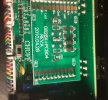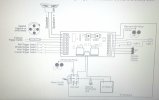maxi-model
UK/US/ROW steam narrow gauge railways 1:1
Max, you said: "
I have never seen a live steamer with a sound card fitted."
no specification that it had to be 16mm... nor is it the wrong scale for standard gauge.... When you make a general statement, you get a general answer...
Be careful with "never", "always", etc.
Anyway many people made fun of it, but turns out that you cannot get a prototypical chuff or whistle from a small model. It actually sounded pretty neat.
If one wants to be pedantic, yes, I said I had not seen one. That does not mean I was not aware one existed. Max




